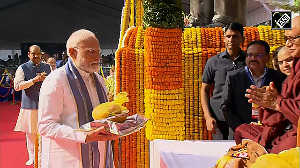Kolkata is in the midst of a real estate boom, but there's one structure coming up in New Town, Rajarhat that will stand out of the concrete jungle - simply because it won't be built of concrete at all, but steel.
The project is being developed by Living Steel, a consortium of the world's 11 largest steel makers to promote the use of the alloy in the housing sector. Locally, Living Steel has tied up with a developer, Bengal Shrachi Housing Development, to build the structure, which will, in all likelihood, be G+3 or G+4, and have six to eight apartments of 1,200-1,800 sq ft each.
Steel houses may sound outlandish but they are quite common in many parts of the world, especially Finland and Australia. A number of famous structures, the Petronas Towers and the Brooklyn Bridge to name two, are largely made of steel.
Even in India, steel sheds and warehouses are quite common in the industrial sector. In 2003, Tata Steel built a clubhouse and two bungalows in Jamshedpur entirely of steel. But these were primarily showpieces put up by the steel manufacturer to show that it was possible to make steel houses, and that people could live in them.
Jatinder Singh, the architect of the steel model bungalows, has been living in one of them for two-and-a-half years. "It's the same as living in a concrete house," he says.
The only difference is that he can't just hammer a nail anywhere he wants when he'd like to hang a painting. He has to find out exactly where the steel supports behind the cement-fibre-board walls are located and drill the nail in there.
The Rajarhat project too is a promotional exercise by Living Steel - to "create excitement about steel construction", as Scott Chubbs, programme director, puts it.
To this end, Living Steel instituted an international architectural competition in July last year to design a liveable, environmentally sustainable house using steel. The house in Rajarhat is to be built according to the design that wins this competition. But the Rajarhat project is also a commercial venture - in the sense that the flats will be sold to the general public.
According to Hem Mishra, president-engineering, Bengal Shrachi, advertisements will be placed in the media for buyers, presumably from among high-income yuppies, emphasising the attitude aspect of living in a steel house.
Whatever the general perception is, proponents of steel believe that as a construction material steel scores over concrete in a number of ways.
As the Living Steel website explains, "The strength to weight ratio of steel is the highest of any residential building material and it can be easily formed and joined. Because steel is strong and lightweight, it is beneficial for builders to work with and can be engineered to better withstand hurricanes and earthquakes." That's not all - steel houses are far more durable than concrete ones, which require regular maintenance, painting and so on.
One real advantage of a steel house will lie in the fact that, since such a house would need to be mostly prefabricated, its construction would be less noisy and dusty, and faster and cheaper. This is what makes steel houses ideal as temporary shelters in disasters, proof of which is the 500 steel structures that Tata Steel built for tsunami victims in Tamil Nadu.
Similarly, Kirby India had put up 3,000 structures after the earthquake in Gujarat. Most importantly, steel allows large column-less spaces of up to 40 metres, important in structures such as airport hangars, sports complexes and factory floors.
A common apprehension is that it would be very hot inside a steel house. Jatinder Singh disagrees - his house is at least a degree cooler than concrete houses, he maintains. There are three reasons for this. Steel walls, which have a far smoother surface than concrete, reflect far more light.
Some products used in steel construction have an aluminum coating to increase reflectivity. Secondly, sheets as thin as 0.8 mm to 2.5 mm are used and this brings down the conduction of heat. Thirdly, insulation materials like EPS (expanded polystyrene), fibreglass or rockwool are used. Architectural features like a pitch roof, translucent glazing and big windows for cross ventilation can also bring down temperatures inside a steel house.
As for pricing, the cost per sq ft of construction of the Rajarhat houses will be around Rs 550, not significantly higher than the Rs 500 that it costs to make concrete structures.
According to Salman Sayeed, vice president-engineering and operations, Minean Habitat, which has built steel huts for lower-income groups in Hyderabad and two schools in Sonari, "Cost varies with the quality of the finishes and the nature of the building. Overall, our systems are 'cost effective' and provide a solution with distinct advantages over conventional construction in several types of projects where speed, quality and volumes are major criteria."
Of course, for some like R N Roychoudhury, vice-chairman of the West Bengal Housing Board and the structural engineer of the second Hooghly bridge, there's no beating concrete when it comes to bridges and other "structures which are to carry heavy loads, especially with recent developments like redimix cement".
But even if there is a case for steel in the housing sector, it will take a long time to change the mindset of people. In fact, Living Steel is not even talking of all-steel houses just yet. All it wants to do is "grow the market for steel in construction".
Launched in February 2005, it has five years and a budget of euro14.25 million to increase the use of steel in construction by up to 10 percent. Thus Anand Sen, vice president (flat products), Tata Steel, talks about "optimal solutions" and designs that "include steel holistically".
At present, steel is used in India primarily as reinforcement for cement. The ratio of steel to brick and concrete here is still in single digits; while globally, where composite construction techniques have become the norm, the figure is far higher at 1:1.5, says Mishra of Bengal Shrachi.
Which brings one to Tata-Bluescope, the joint venture between Tata Steel and Bluescope Steel of Australia, the market leader in metallic coated and pre-painted steel products, which are used extensively in pre-engineered buildings.
With one manufacturing facility in Pune, three more coming up in Delhi, Chennai and Jamshedpur, 18 sales offices all over India, and the Tata Steel supply chain at its disposal, the joint venture is intended to tap the market for pre-engineered buildings and processed steel building products in India and south Asia.
Already, it has landed four big contracts to build industrial spaces for L&T, ITC, Tata Autocom and Flextronics. Among other projects, it has also built the additional district magistrate's office at Duburi in Orissa.
But public opinion is increasingly coming to accept steel in industrial spaces or even low-cost mass housing and community spaces like health centres and schools. Kirby India and Minean Habitat. Both of which specialise in pre-fabricated buildings made primarily of steel, have successfully executed a number of such projects.
The latter has executed the Tata Steel projects, besides the faculty and administration buildings of the Baba Ghulam Shah Badshah University in Rajouri, while the former has done projects as diverse as canopies for Reliance petrol stations, sheds for the Delhi Metro Railway and a 32-metre-high hulk shop for Garden Reach Ship Builders.
For the proponents of steel in construction, the real challenge lies in the residential sector, to overcome the resistance of people like you and me to steel houses. Will the Rajarhat project help to do that?Do you want to discuss stock tips? Do you know a hot one? Join the Stock Market Investments Discussion Group







 © 2025
© 2025